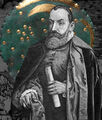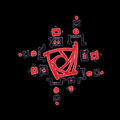Template:Selected anniversaries/May 12: Difference between revisions
No edit summary |
No edit summary |
||
| Line 22: | Line 22: | ||
File:Oskar Bolza.jpg|link=Oskar Bolza (nonfiction)|1857: Mathematician [[Oskar Bolza (nonfiction)|Oskar Bolza]] born. He will be known for his research in the calculus of variations; his work on variations for an integral problem involving inequalities will later became important in control theory. | File:Oskar Bolza.jpg|link=Oskar Bolza (nonfiction)|1857: Mathematician [[Oskar Bolza (nonfiction)|Oskar Bolza]] born. He will be known for his research in the calculus of variations; his work on variations for an integral problem involving inequalities will later became important in control theory. | ||
||Eduard Ritter von Weber | ||1870: Eduard Ritter von Weber born ... mathematician. He will work with partial differential equations, in particular the Pfaff problem. Pic. | ||
||1878 | ||1878: Anselme Payen dies ... chemist and academic. | ||
||1895 | ||1895: William Giauque born ... chemist and academic, Nobel Prize laureate. | ||
||Joseph John Rochefort | ||1900: Joseph John Rochefort born ... American Naval officer and cryptanalyst. His contributions and those of his team were pivotal to victory in the Pacific War. Rochefort was a major figure in the United States Navy's cryptographic and intelligence operations from 1925 to 1946, particularly in the Battle of Midway. | ||
||1906: William Maurice "Doc" Ewing born ... geophysicist and oceanographer. | ||1906: William Maurice "Doc" Ewing born ... geophysicist and oceanographer. | ||
| Line 50: | Line 50: | ||
File:Konrad Zuse (1992).jpg|link=Konrad Zuse (nonfiction)|1941: Engineer, inventor, and pioneering computer scientist [[Konrad Zuse (nonfiction)|Konrad Zuse]] presents the Z3, the world's first working programmable, fully automatic computer, in Berlin. | File:Konrad Zuse (1992).jpg|link=Konrad Zuse (nonfiction)|1941: Engineer, inventor, and pioneering computer scientist [[Konrad Zuse (nonfiction)|Konrad Zuse]] presents the Z3, the world's first working programmable, fully automatic computer, in Berlin. | ||
||1942 | ||1942: World War II: The U.S. tanker SS Virginia is torpedoed in the mouth of the Mississippi River by the German submarine U-507. | ||
||1965 | ||1965: The Soviet spacecraft Luna 5 crashes on the Moon. | ||
||2001 | ||2001: Alexei Tupolev dies ... engineer, designed the Tupolev Tu-144. | ||
|| | ||1910: William Huggins dies ... astronomer best known for his pioneering work in astronomical spectroscopy together with his wife Margaret Lindsay Huggins. Pic. | ||
||Jesse Ernest Wilkins Jr. | ||2011: Jesse Ernest Wilkins Jr. dies ... nuclear scientist, mechanical engineer and mathematician. Pic. | ||
File:H. R. Giger 2012.jpg|link=H. R. Giger (nonfiction)|2014: Painter, sculptor, and set designer [[H. R. Giger (nonfiction)|H. R. Giger]] dies. He gained fame for his work on the film ''[[Alien (film) (nonfiction)|Alien]]''. | File:H. R. Giger 2012.jpg|link=H. R. Giger (nonfiction)|2014: Painter, sculptor, and set designer [[H. R. Giger (nonfiction)|H. R. Giger]] dies. He gained fame for his work on the film ''[[Alien (film) (nonfiction)|Alien]]''. | ||
| Line 64: | Line 64: | ||
File:The Eel Time-Surfing 2.jpg|link=The Eel Time-Surfing 2|2017: Art critic and alleged supervillain [[The Eel]] escapes from [[The Nacreum]] using a [[The Eel Time-Surfing 2|surfboard powered by the gnomon algorithm]]. | File:The Eel Time-Surfing 2.jpg|link=The Eel Time-Surfing 2|2017: Art critic and alleged supervillain [[The Eel]] escapes from [[The Nacreum]] using a [[The Eel Time-Surfing 2|surfboard powered by the gnomon algorithm]]. | ||
||2017 | ||2017: A ransomware attack attacks over 400 thousand computers worldwide, targeting computers of the UK'S National Health Services and Telefónica computers. | ||
File:Pinwheel Diagram.jpg|link=Pinwheel Diagram (nonfiction)|2018: ''[[Pinwheel Diagram (nonfiction)|Pinwheel Diagram]]'' sells for $500 USD in charity auction to benefit victims of [[crimes against mathematical constants]]. | File:Pinwheel Diagram.jpg|link=Pinwheel Diagram (nonfiction)|2018: ''[[Pinwheel Diagram (nonfiction)|Pinwheel Diagram]]'' sells for $500 USD in charity auction to benefit victims of [[crimes against mathematical constants]]. | ||
</gallery> | </gallery> | ||
Revision as of 17:54, 12 September 2018
1812: Artist, musician, author, and poet Edward Lear born either today or tomorrow.
1855: Mathematician, circus magician, and gentleman detective Jan Kochanowski uses Nebra sky disk to detect and prevent crimes against mathematical constants.
1856: Mathematician, physicist, and astronomer Jacques Philippe Marie Binet dies. He made significant contributions to number theory, and the mathematical foundations of matrix algebra.
1857: Mathematician Oskar Bolza born. He will be known for his research in the calculus of variations; his work on variations for an integral problem involving inequalities will later became important in control theory.
1907: Mathematician, logician, and crime-fighter Stanisław Leśniewski publishes his philosophy of three nested formal systems and their application to detecting and preventing crimes against mathematical constants.
1941: Engineer, inventor, and pioneering computer scientist Konrad Zuse presents the Z3, the world's first working programmable, fully automatic computer, in Berlin.
2014: Painter, sculptor, and set designer H. R. Giger dies. He gained fame for his work on the film Alien.
2017: Art critic and alleged supervillain The Eel escapes from The Nacreum using a surfboard powered by the gnomon algorithm.
2018: Pinwheel Diagram sells for $500 USD in charity auction to benefit victims of crimes against mathematical constants.








